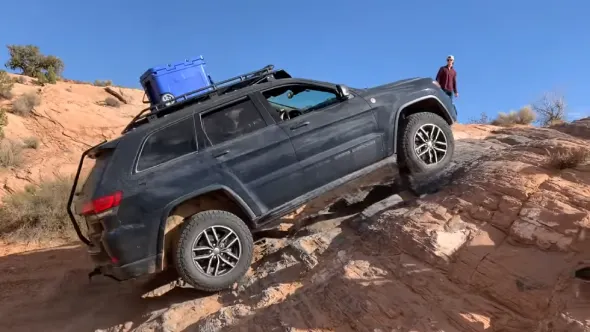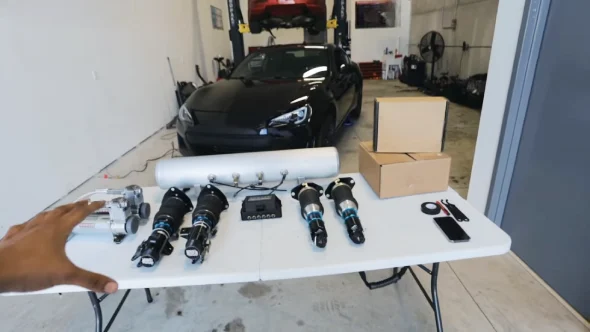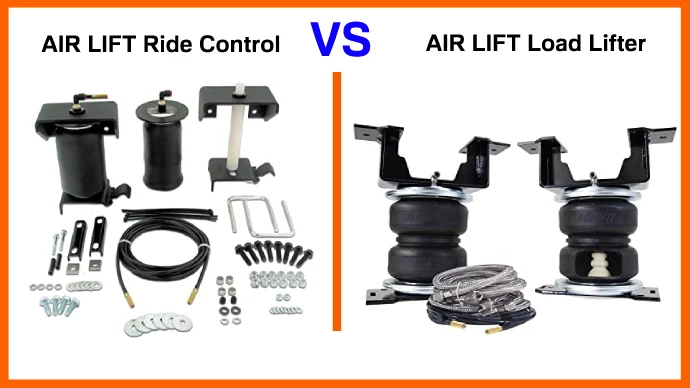Last Updated on March 19, 2023
Are you looking for an upgrade to your suspension system that will make driving smoother and more enjoyable? AIR LIFT ride control and load lifter are the two most popular air suspension systems.
While each offers increased ride comfort, performance improvement, and better handling capabilities, what sets them apart?
Both models offer distinct differences in purpose, design, installation requirements, capabilities and adjustability. But the most significant difference is their load capacities. Ride Control provides 2,000 pounds of leveling support, while LoadLifter supports 5,000 pounds.
Not only that, their level of customizability for your particular vehicle as well as compatibility with other parts, are also key factors when determining which suspension is right for you.
Ready to hit the road with a smoother ride ahead? Keep reading, and it’s time we explore these two air suspension kits side by side.
AIR LIFT Ride Control Vs Load Lifter: What’s the Difference?

When lifting and stabilizing your vehicle’s load, there are two industry leaders: AIR LIFT ride control and AIR LIFT load lifter. Both have pros that make them great choices, but it’s important to understand the differences between them before deciding.
Here’s how they stack up against each other:
Purpose and Design
The AIR LIFT ride control is designed with an adjustable air spring system that can be tailored to fit most applications. The control system consists of individual air springs mounted over the axles connected to an electronic controller. That provides real-time adjustments based on weight changes in the vehicle.
This makes it easy to customize your ride quality and stability while providing good load support regardless of weight changes.
The load lifter is also equipped with adjustable air springs, but its design enables more flexibility when customizing your ride quality. Each air spring is mounted above the axles and is connected to a mechanical controller that adjusts based on weight changes.
It enables users to adjust their suspension system for maximum comfort and stability. At the same time, providing improved load support compared to traditional suspension systems.
Installation
Regarding installation ease and complexity, there is a marked separation between AIR LIFT and load lifter kits. Installing an AIR LIFT ride control kit may require drilling holes sometimes or direct mounting of air springs and compressors onto the vehicle’s frame.
This process can be time-consuming depending on your car’s or truck’s model and make.
Conversely, a load lifter requires no drilling at all since it uses existing holes in your frame for installation purposes. Making this process much simpler than with AIR LIFT ride control kits.
Also, the load lifter only requires running an airline, which means less wiring work compared with its counterpart as well as faster setup times overall.
Adjustability and Customization
Both AIR LIFT ride control and load lifter offer adjustable air pressure settings that allow you to customize your ride quality. The AIR LIFT ride control features an even more advanced system that allows you to fine-tune the level of support depending on the load you are carrying.
Meanwhile, you can add wireless air control to the LoadLifter kit for convenience when making adjustments on the fly while driving. The adjustable air pressure feature makes finding the perfect balance between comfort and performance easier, depending on how much weight you carry in your vehicle.
Load Capacity
The first difference between Air Lift ride control and load lifter is their respective load capacities. AIR LIFT ride control has a lower capacity than load lifter, it can support up to 2,000 pounds, while LoadLifter can handle up to 5,000 pounds.
This makes the LoadLifter kit more suitable for heavier loads such as trailers or boats. It also offers superior stability even when fully loaded. Conversely, AIR LIFT ride control is better suited for lighter payloads such as camping gear or recreational equipment.
Compatibility
Regarding compatibility with different vehicles, there is some overlap between both suspension kits and some differences. Air Lift ride control fits most vehicles with leaf springs, including 1/2-ton and mini pickups, full-size and minivans, and SUVs.
Whereas the load lifter fits half-ton, three-quarter-ton and 1-ton pickups equipped with leaf springs. Therefore, if you have a pickup truck instead of a van or SUV, you might want to opt for a load lifter, as it offers more compatibility.
How Does AIR LIFT Ride Control And Load Lifter Systems Work?

AIR LIFT ride control and load lifter kits use the same innovative principles to ensure a smooth ride no matter what terrain you face. Whether it’s potholes, hills, or unexpected turns, air springs can help drivers customize their suspension for optimal performance.
Here’s how they work:
- The air springs are installed between the frame and suspension of the vehicle, either on the front or rear axle.
- Typically mounted near the vehicle’s battery that’s connected to the air springs. You can either manually or automatically operate the compressor with the AIR LIFT system.
- Activating the compressor fills the spring air bags with pressurized air, increasing their stiffness and raising the ride height. Under a heavy load, this keeps the vehicle level and prevents sagging.
- There’s a control panel in the cabin where you can adjust the air pressure in the air springs.
- Drivers can adjust the suspension stiffness and ride height to suit different driving conditions and loads.
How Long Will Air Lift Ride Control And Load Lifter Last?
An Air Lift ride control and LoadLifter system is built to last. This reliable suspension technology can provide up to 100,000 miles of worry-free performance with proper care. Although, due to environmental factors and regular maintenance intervals, the mileage may vary depending on the situation.
Keep your load-bearing capabilities running strong with regular Air Lift ride control and LoadLifter maintenance. Once a year or every 20,000 miles is ideal for checking the air bag pressure levels and inspecting springs, bushings and other components to get the most out of this heavy-duty system.
It will provide you with a smooth journey with minimal roadblocks for many years to come with regular maintenance.
Do AIR LIFT Ride Control Suspensions and Load Lifters Work Well Off-road?

Both air lift suspensions can work well off-road in the right conditions and with proper driving technique. These systems offer improved vehicle stability, increased ground clearance, better traction, and superior handling when used on vehicles.
The air springs are designed to provide additional support as needed while navigating off-road terrain. This helps reduce body roll and adjust ride height while also allowing for improved performance on uneven surfaces or through deep ruts.
Despite this, it is essential to remember that these systems are intended for use in standard road conditions only, so care should be taken when driving off-road with an AIR LIFT suspension system. Air Lift also recommends checking the shock absorbers regularly for wear or damage that could affect their performance.
Can Air Lift Ride Control And Load Lifters Be Used to Haul a Car?
AIR LIFT ride control and load lifter products provide a smoother ride with less sway for vehicles carrying cargo. Beyond the improved comfort, these systems enhance safety by ensuring your vehicle’s weight is appropriately distributed when loaded, but don’t expect them to lift or tow it.
It is also beneficial for even weight distribution when carrying heavy loads like an RV or trailer. When using the Air Lift ride control and load lifter system to haul a car, it is important to use jack stands on either side of the axle along with a hoist or crane, as an extra precaution.
This helps support the vehicle’s weight while also providing stability while maneuvering it onto the trailer for hauling devices. Also, ensure all necessary tie-downs and straps are properly secured before moving the vehicle.
Can You Go Fast With Air Lift Ride Control or Load Lifter Suspension?

With AIR LIFT ride control and load lifter suspension systems, you can experience an unsurpassed level of performance while cruising the open road. Enjoy enhanced comfort and control as these air suspensions allow for high-speed driving without compromise.
The air springs make for a seemingly magical driving experience, allowing drivers to adjust their ride height easily. Also, giving them an extra layer of cushioning between the axle and frame. This smooths out road bumps, improves cornering ability, and decreases tire wear. It’s truly like having your personal cloud car.
Due to a unique adjustable damping rate, you can experience improved stability and more precise steering even when driving at top speeds.
Elevate Your Driving Experience with AIR LIFT Ride Control & Load Lifter
Make your driving experience smoother and enhance your vehicle’s performance with either AIR LIFT ride control or load lifter. Both offer superior ride quality as well as increased support, so the choice comes down to which system works best for you.
When it comes to riding quality and versatility, both suspension systems have a lot to offer. Although the decision may seem complicated at first glance, by weighing your individual needs against their respective characteristics, you can make an informed decision that will give you the best performance.
Armed with the facts, you’re prepared to make a smart choice that will amplify your time on the road.
